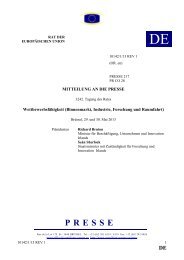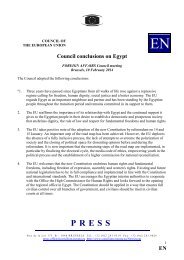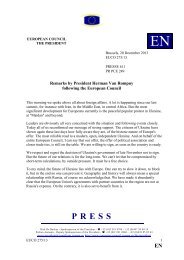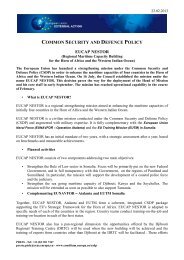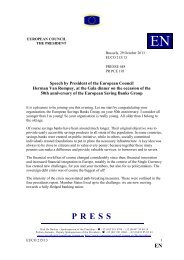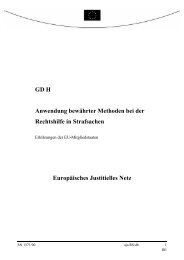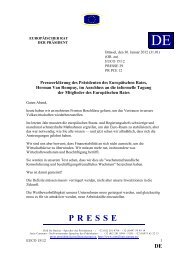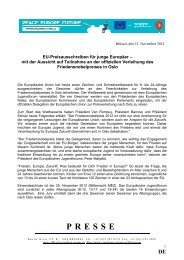14508/09 ADD 1 PL/vk 1 DG G COUNCIL OF THE ... - Europa
14508/09 ADD 1 PL/vk 1 DG G COUNCIL OF THE ... - Europa
14508/09 ADD 1 PL/vk 1 DG G COUNCIL OF THE ... - Europa
You also want an ePaper? Increase the reach of your titles
YUMPU automatically turns print PDFs into web optimized ePapers that Google loves.
Indicator 3: measures the proportion of women and men in a population who have died from cardio-<br />
vascular disease (ischemic coronary heart disease, stroke and other cardio-vascular diseases). The<br />
data behind this indicator are compiled from statistics based on the causes of death on death<br />
certificates, which all EU Member States are obliged to issue. A number of projects within the EU<br />
have worked on this indicator, including Eurosciss 1 and 2. In Eurosciss 2 work started 2003 on<br />
producing a list of European information sources, available indicators, and a description of the<br />
differences in methods of gathering data according to the recommendations set out in the European<br />
Community Health Indicators (ECHI II), which has an updated list of indicators for reporting<br />
cardio-vascular diseases in relation to age and region (Eurosciss 1 and 2 ECHI II).<br />
According to the Austrian report, cardio-vascular diseases are the most prevalent cause of death in<br />
the EU and represent more than 1.9 million deaths per year. Almost 32 % of all deaths in the EU in<br />
2001 were caused by cardio-vascular disease (46 % of deaths among women and 39 % of deaths<br />
among men). Cardio-vascular disease is the most common cause of death among women in all EU<br />
countries. Ischemic coronary heart disease is the most common single cause of death in the EU;<br />
killing every tenth man and every seventh woman. Stroke is the second single most common cause<br />
of death in the EU, killing every tenth man and every eighth woman.<br />
4.3.3 Trends emerging from EU-wide data.<br />
Data are available for 2006 from EU 25 countries (except IT and UK). There are great differences<br />
in healthy life years between countries for both men and women: the figures range from<br />
approximately 50 years minimum for men (EE) to almost 70 years maximum for women (MT)<br />
(figure 4.3.1). In more than half the countries, women have a higher HLY than men, with the<br />
greatest difference in Estonia and Poland, where women have 4 more HLY than men. Among<br />
countries where men have a higher HLY than women, the difference is largest in Portugal (2 years),<br />
followed by the Netherlands. In several countries the differences are small (figure 4.3.2).<br />
Analyses of trends over a certain time period are difficult to assess due to the methodological<br />
differences in collecting data. Another measure (available in Eurostat) is HLY at age 65, which<br />
assesses the health of the older part of the population and may give an idea of the future health<br />
challenges facing the EU MS as the proportion of their elderly citizens grows.<br />
<strong>14508</strong>/<strong>09</strong> <strong>ADD</strong> 1 <strong>PL</strong>/<strong>vk</strong> 66<br />
ANNEX <strong>DG</strong> G EN





